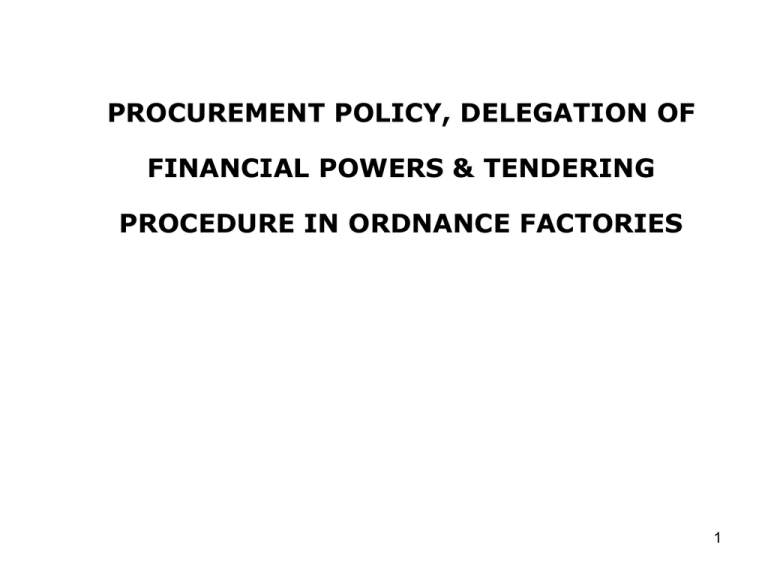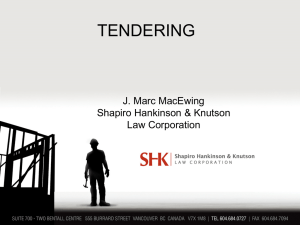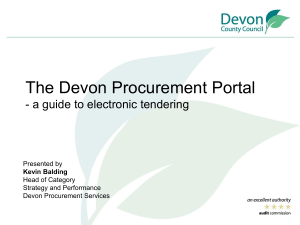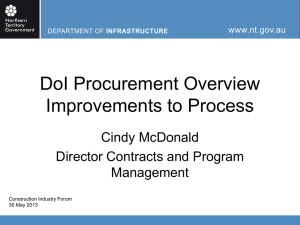Procurement Policy in Ordnance Factories
advertisement

PROCUREMENT POLICY, DELEGATION OF FINANCIAL POWERS & TENDERING PROCEDURE IN ORDNANCE FACTORIES 1 PROCUREMENT POLICY IN ORDNANCE FACTORIES • TO PROCURE WORK, MATERIAL, SERVICES • OF THE SPECIFIED QUALITY • WITHIN THE SPECIFIED TIME • AT THE MOST COMPETITIVE PRICES • IN A FAIR, JUST & TRANSPARENT MANNER • RESPONSIBLITY AND ACCOUNTABILITY 2 DELEGATION OF FINANCIAL POWERS • New Management Strategy • Decentralization of decision making process to increase efficiency and effective utilization of resources by actual operators • Responsibility and accountability 3 CIVIL CAPITAL CIVIL WORKS FOR PRODUCTION BUILDINGS LEVEL-I GM LEVEL-II AGM 5 CRORE 1 CRORE CAPITAL CIVIL WORKS FOR NON 1 CRORE PRODUCTION BUILDINGS NIL CAPITAL CIVIL WORKS FOR AMENITY BUILDINGS AND RESIDENTIAL ACCOMODATION REVENUE CIVIL WORKS 1 CRORE NIL 0.5 CRORE 0.1 CRORE PERIODICAL SERVICES FULL 1 CRORE 25 CRORE 1 CRORE Full – for purchase from DGS&D under Rate/ Running contract NIL LEVEL-III LEVEL-IV 1 CRORE 10 LAKHS 1 CRORE 10 LAKHS P&M Procurement, modification and/or re-conditioning of P & M through LTE/OTE under RR and NC Procurement, modification and /or 1 CRORE re- conditioning of P&M on single tender/ resultant single tender or proprietary items under RR and NC. STORES Procurement of stores against 20 CRORE LTE/OTE or Rate / Running contract placed by DGS&D or OFB or from M/S Rosoboronexport, Russia. Procurement of Stores (i) Of 1 CRORE proprietary articles on single tender, (ii) From single known source, (iii) Where resultant single acceptable offer is received against LTE/OTE Procurement of stores against ab- 5 LAKHS initio single tender. 5 CRORE Placement of Development orders. 5 LAKHS NIL Direct Purchase of Steel & Alloys from Public Sector 5 CRORE FULL 50 LAKHS NIL 4 The Basics • Capital Procurement: •Expenditure with the objective of increasing assets • Primarily bears first charge for first construction • Costing more than Rs 10 lakhs and with a life of 7 years as per GFR. • Procurement procedure documented in DPP, Guidelines for Procurement of P&M in Ordnance Factories etc. • Revenue Procurement: •All subsequent charges for production, maintenance and working expenses • For items and equipments to maintain and operate already sanctioned assets • Procurement procedure documented in DPM, OFB procurement manual 5 ACCEPTANCE OF NECESSITY Assessment of physical requirement of resources with respect to targets fixed and budget availability • Purchase of stores must be made • in the most economical manner • in accordance with definite requirements • Stores should not be purchased in small quantities. • Stores should not be purchased much in advance of actual requirements which will result in locking up of capital • Elements: • Vetting of estimated requirements / SHIS • Vetting of estimated cost • Mode of tendering and source of procurement • Availability of funds and head of account. 6 ACCEPTANCE OF NECESSITY..contd • For scaled items utmost care to be taken to incorporate: • Available stock • outstanding dues/supplies • Past consumption patterns • average life of equipment and spares • Clubbing of requirements • For one time purchase for projects or capital equipments • Actual requirement usage • Rate of return • Obsolescence factor • Confirmation to latest technology and specifications 7 ACCEPTANCE OF NECESSITY..contd • Estimated cost is the most important element of AON. • Basis of estimation: • L.P.P. • Budgetary quotations from established / registered vendors, • Assessed cost by specialist officer, in case of non-standard giving an objective cost break-up, etc. • Informal enquiries with vendors should be avoided • Estimated cost is often inflated and prepared in perfunctory manner, escalating at a uniform rate without assessing market trends which results in an acceptance and payment of higher prices. • Budgetary provision / availability of funds and head of account are to be clearly assessed during acceptance of necessity. • Mode of tendering, as also sources of procurement i.e. from trade or P.S.U.s or from import, to be clearly decided at this stage. 8 Tendering Modes • PAC • Items/equipments that are proprietary products of manufacturer: specifications not available to others to manufacture • PAC issued to OEM by user • PAC valid for one year from date of issue. • Single Tender Enquiry: • Invitation to one firm • For non PAC items can be resorted to on grounds of urgency, operations and technical requirements • Reasons must be recorded • Reasonableness of rates must be determined 9 Tendering modes..contd Limited tender enquiry • To be adopted when estimated value of procurement is below Rs 10 lakhs and sources of supply arewell known; new source unlikely • List of credible suppliers; competition to be encouraged • Web based publicity • Sufficient time to be allowed to vendors to quote Open tender enquiry • Preferred mode for common use items of generic or commercial specifications, adopted when estimated value of procurement is above Rs 10 lakhs • Wide publicity through advertising media, internet • Four weeks allowed for submission of bids. 10 Vendor Selection • Selection and registration of firms/suppliers and their evaluation must be clear and transparent. • Users required maintain a list of approved vendors / contractors • Prequalification necessary to bring competent contractors into competition with technical & financial capability required for the particular procurement. To be done on the basis of : • Experience and past performance on similar contracts • Capabilities with respect to personnel, equipment and manufacturing facilities • Financial standing through latest I.T.C.C., Annual report (balance sheet and P & L account) of last three years. 11 Vendor Selection..contd • PQ evaluation criteria must be incorporated in the bid documents in clear and unambiguous terms • Prepare the PQ criteria specific to the requirement of the work. • Evaluate the bids exactly as per the notified criteria. 12 Specification/QRs •Detailed QRs for the item to be procured should indicate • Material composition • Physical and performance parameters • Tolerances if any • Manufacturing processes where applicable • Test schedule • Preservation and packing • QRs must be finalized before tendering. • No waiver or modification of QRs allowed after issue of TE. 13 Bid system • Single bid or two bid (for T/P, IT and communications systems, turn key projects) • Two bid system: techno-commercial and price bids are called separately. • The techno-commercial bid contains all terms and conditions including commercial terms except price. • Technical bids will be evaluated by T.E.C. • Price bids of only technically acceptable offers are to be opened to ensure an objective evaluation of tenders. • Single stage two bid system is followed in MOD and widely prevalent, being most transparent. • In case of two-stage two bid system, price/commercial bids are called from only technically acceptable vendors after technical evaluation. 14 Preparation of tender documents Stipulate all prevailing standard conditions, Govt.policies: • Eligibility : registration with DGQA, OFB etc • Clarifications on bidding documents: • Amendment to bidding documents: can be done before date of submission of bids • Bid validity: 90 days for single bid and 120 days for two bid tender • Late bids • Modification and withdrawal of bids: can be done before deadline for submission of bids • Clarification of bids: no change in price or substance permitted • Agents of supplier: one agent cannot represent two suppliers 15 Preparation of tender documents..contd Stipulate all prevailing standard conditions, Govt.policies: • Preliminary examination: Completeness of bid and substantially responsive bids • Evaluation of substantially responsive bids: On basis of prices offered • Award criteria: Meeting all technical and commercial conditions and lowest 16 Preparation of tender documents..contd Special conditions: • Delivery schedule and place: Clear and unambiguous • Payment terms and paying authority • Security Deposit: @ 10% (max) of the total value of each contract within 20 days of the receipt of acceptance of tender. • Liquidated damage: recoverable @ 0.5% of value of undelivered goods for each week or part thereof, not exceeding 10% of the outstanding contract/supply value • Earnest Money Deposit: @ 3 % of the estimated value of the tender and may not exceed 5 %. EMD forfeited, if the tenderer withdraws or amends, impairs or derogates from the tender in any respect within the period of validity of his tender. • Fall clause 17 Preparation of tender documents..contd Special conditions: •Risk and expense purchase: Supplier liable to pay additional amount as compared to original contracted amount. Difficult to enforce. •Option Clause and repeat order: Right to vary quantities at same rates and terms within delivery period: Increase/decrease upto 100% of quantity specified provided there is no downward clause. • Force majeure: Need not be included in TE • Price Variation Clause: when included items and formula on which the price variation is based should be clearly spelt out indicating the base price of the raw materials, etc., on which variation is to be allowed 18 • Arbitration: Must indicate provisions for appointing arbitrator. Tender Invitation and Receipt • Prefer open tendering as far as possible • In case limited tenders are resorted to, prepare a panel of contractors/ vendors in a transparent way. •Ensure adequate & wide publicity: Upload NIT & tender document on web-site, even in case of limited tenders. • Conduct pre-bid meeting • to bring clarity regarding sprit of various provisions • to bring necessary modifications , if required. • Make suitable arrangement for receipt of sealed tenders at scheduled date and time through conspicuously located tender boxes. •For bulky tender documents, keep provision in tender documents, for submission of bids by hand to designated officials 19 Tender Opening • Tenders to be opened by Tender opening Committee in presence of firms or their authorized representative at particular date and time, specified in T.E. • Each tender to be numbered serially, initialed and dated on first page. Prices, important terms and conditions etc. should be encircled and initialed by tender opening officers / committee. • Each page of the tender should also be initialed with date and particularly, alterations in tenders made by the firms, to be initialed. • In two bid system, only technical bids to be opened first. Sealed commercial bids should be initialed by BOO • Late tenders, delayed tender offers not to be considered at all. • Board of Officers should not be connected with procurement activities at particular date and time specified in the tender enquiry. 20 Tender Evaluation • Technical evaluation: – Whenever a two bid system is followed – Evaluation by a Technical Evaluation Committee- IFA not part of it – To ascertain conformity of technical bid with technical specifications sought – To bring all bidders on a level playing field in qualitative requirement – Report to be submitted to CFA for approval. • Commercial evaluation: – Evaluation by a Tender Purchase Committee- IFA a part of it – Comprises of Users, technical member, CFA rep and IFA – PNC/TPC shall maintain a self-speaking record of its work in chronological manner. – Minutes are to be page numbered and signed – Issues to be seen: • Duties and taxes • Delivery period and delivery compliance • All inclusive cost on delivery. 21 Negotiations • Negotiations should be held in rare and exceptional circumstances where rates are not found reasonable. • Negotiations with LI/ techno-commercially acceptable vendor only: – When there is inadequate competition in LTE. – Wide variation between quotes of L1 and L 2 and others – Wide variation between estimated cost and tendered cost. – In case of proprietary items procured on single tender where reasonability of rates cannot be justified. – Where all tenders/firms quoting one make but different prices and terms and conditions 22 Negotiations..contd • CVC guidelines: – Post tender negotiations are banned with immediate effect except with L1 – There should not be any negotiations. Exceptions will be only in the case of proprietary items or in items with limited source of supply. Counter offers tantamount to negotiations. – When the quantity to be ordered is much more than what L-1 alone can supply, the quantity order may be distributed in such a manner that it is fair, transparent and equitable. 23 Tender Evaluation and Award of Work Concern areas: • Evaluate tenders exactly as per notified criteria • Timely decision within validity period • Comply with instructions/guidelines of CVC on negotiations • Ensure that conditions/specifications are not relaxed in favour of vendor to whom work is being awarded. • Ensure that L1 is not ignored on flimsy ground. • Ensure that supply order is placed within justified rates • Incorporate all standard terms and conditions, rates, denominations and specifications as per TPC’s decision. • Do not deviate materially from any tender enquiry condition • Match agreement with the tender document, properly document, sign and seal • Ensure acceptance of contract/supply order by vendor. 24








